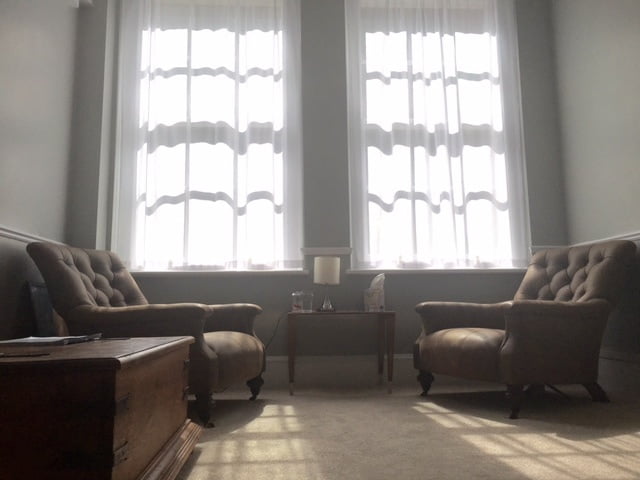What not to expect in a hypnotherapy session:
As a potential client, you may be curious to know what not to expect in a hypnotherapy session. I think there’s a lot out there about what to expect, however, there’s not really that much about what not to expect.
I’ve based this blog based on real feedback from some of the 2500 plus clients I’ve seen and their most common misconceptions. On talking with many other hypnotherapists, I find that versions of this list comes up quite a lot.
Hopefully, this will inform your opinion about what to expect and equally not to expect with working with a hypnotherapist. And if you want to find out more, then do get in touch.
A sofa
As you can see from the picture of my office below, there’s no sofa. Some clients are even surprised when they walk in and see two chairs and no sofa. The chairs are incredibly comfortable and clients find them incredibly relaxing.

Modern hypnotherapy has really virtually nothing to do with antiquated ideas involving sofas and lying down. And certainly not sleep. Hypnosis is not sleep.
This is because ultimately, clinical hypnotherapy is about you and I having a discussion and applying very powerful techniques. These techniques do not involve sleep and are designed to either help you start something and do it more, or stop something and do it less. As such, sitting down is far more appropriate.
Plus you need to be aware of what’s going on during the process. That said, the chairs are very, very comfortable. I purposely chose them because I think the whole experience of being in a hypnotherapy room should be really nice & comfortable. So many therapists have rubbish chairs from IKEA.
Tea and sympathy
Having worked with over 2500 hypnotherapy clients, I can tell you that based on that experience, that clients come to get results. I am committed to being warm & compassionate and kind with my clients.
However, that doesn’t mean that I am going to feel sorry for you, nor ask you to go into minute detail about things. My aim is to help you be free of events & emotions which are holding you back and give you some coping skills and strategies with which to help you move forward.
Given the importance of chemisty in all forms of therapy, it’s vital to find the right therapist for you.
Trying to find out the big ‘why’
Trying to find the great mystery of the ‘big why’, of who you are and why you ended up in the place where you have a problem is not my focus as a hypnotherapist. This is because that can take ages! And even if you do get to the reason ‘why’, you’re still left with the problem.
I genuinely believe that it’s important to focus our efforts on ‘what’ has happened and ‘what’ you need to do instead in order to feel better.
I do understand why trying to find ‘the big why’ is interesting intellectually. However, that is far more the domain of a psychotherapist.
In practical terms, it means we are able to deal with the likes of anxiety and panic attacks in just 1-2 sessions. Contrast this with a client I was talking to who had had 3 years of psychotherapy for two times a week for the same problem and didn’t feel any better.
To feel hypnotised, asleep or anaesthetised.
So much of my work is done with your eyes being open and you will feel completely normal. People will often think there’s a special ‘trance state’, which is like you see on the TV & movies. It’s not. Most clients feel incredibly alert and awake. Only a very small portion of hypnosis involves your eyes being closed. And when that does occur, it’s normally only 10% of people who have a ‘drifty off’ trance like experience like they’re above a cloud.
This is because the idea of trance is incredibly normal and it happens all of the time. Think about it, when you’re playing around on your ‘phone, you don’t think about it. You just do it. Yet, you are in a ‘phone trance’. The same goes for most things in our life e.g. driving, reading, eating, being scared etc. You’re not asleep, you’re not anaesthetised and you are focusing your attention on something.
The very same principle applies in hypnosis. You can have an eyes open hypnotic trance, you can have an eyes closed one. My professional bias leads more to the former, though I pretty much always do the latter also.
Ultimately, hypnosis is about stopping your negative trance state and attempting to replace it with a far more positive one.
To feel negatively emotional
As a hypnotherapist, I spend a huge amount of time working with clients who have negative emotions as a result of bad experiences. However, my job is to help you be able to deal with these emotions, not have to feel the power of them.
As such, I work with clients to help neutralise these emotions and / or the events that may have create them in the 1st place. When working with the likes of phobia’s and panic attacks
I’ll always aim to be compassionate with you. However, if you end up talking endlessly about these events and feelings, you’re likely to get more upset. This is because the part of the brain called the amygdala that regulates painful emotions and memories becomes activated.
It’s why for people often find the likes of CBT and counseling quite distressing.
Because of the likes of the havening technique, it’s possible to do this process very gently, very rapidly and very effectively. Many clients report that they are able to let something go, without feeling it.
Be passive and not have to say or do anything
Hypnotherapy is a 2-way active experience. Having worked with in excess of 2500 people, those clients who are more likely to get the better outcome are those that give 100%. As such, expect to get involved. Put another way, don’t expect to sit there and me give you some wishy-washy suggestions.
Before your appointment, I’ll ask you to do a detailed questionnaire and log of your experiences. It’ll take about an hour of time and it’s time well spent. This is important because it tells me what’s going on and how to work with you. This, as opposed to you just turning up and me having to make things up on the spot.
As Alex Ferguson used to say to his players ‘if you fail to prepare, prepare to fail’.
The same applies in hypnosis too.
For you to have many, many sessions
On average I see clients for 1.5 sessions. This is based on years and years of experience that shows me that it’s totally possible to change very rapidly. If you think about it, we all expect and know from personal experience that we can feel badly, very quickly.
As such, you can feel better about something very rapidly also. However, I accept not all of the time and not necessarily about everything. That said, when working with the likes of trauma, negative experiences, phobias & panic, it is possible to change really quickly. Of course, some clients need a little longer. However, I don’t think I’ve worked with a client for more than 6 sessions.
And finally…
I promise you will never, ever hear me say the words, ‘look into my eyes, not around my eyes, just into my eyes’…
I hope this article gives you an idea of what not to expect in a hypnotherapy session. And if you’d like to find out more about how hypnotherapy may be able to help you, then do get in touch.
Thanks for reading,
James

